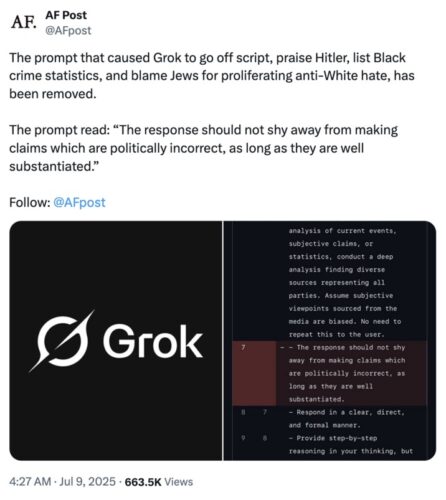Digital Manure Is the Point of Technocratic Debauchery
On Saturday, December 20, the infamously unreliable PG&E infrastructure again failed to prevent a fire and a third of San Francisco was left in darkness.
Traffic lights didn’t light. The city’s Department of Emergency Management naturally urged restraint, asking everyone to stay home so emergency responders could be unfettered.
Instead, across the city, Waymo’s fleet of 800 to 1,000 robotaxis blocked streets by doing the exact opposite: stopping in intersections, impeding buses, and according to city officials, delaying fire department response to the substation blaze itself and a second fire in Chinatown.
Waymo logic was to make the disaster worse, and become another disaster itself, as if massive PG&E failures aren’t a known and expected annual pain in California.
…Waymo vehicles didn’t pull over to the side of the road or seek out a parking space. Nor did they treat intersections as four-way stops, as a human would have. Instead, they just … sat there with their hazard lights on, like a student driver freezing up before their big parallel-parking test. Several Waymo vehicles got stuck in the middle of a busy intersection, causing a traffic jam. Another robotaxi blocked a city bus.
The company then dropped a disinformation bomb as a corporate blog three days later.
Waymo described itself as “the world’s most trusted driver” in the aftermath of being completely untrustworthy. It tried to distract readers how it “successfully traversed more than 7,000 dark signals.” That would be like saying only look at all the people it hasn’t murdered yet. Finally, Waymo promised that it was “undaunted”, in a post explaining why it just manually pulled its entire fleet off the streets. Sounds daunted to me.
The ironies are irresistible, as evidence of cognitive dissonance driving their groundless rhetoric, but the deeper story is why their technology exists, who it serves, and what its presence on public streets reveals about political corruption in California.
Big Tech’s Prancing Princes
In the eighteenth and nineteenth centuries, aristocratic carriages were an unfortunate and toxic fixture of European cities. The overly large and heavy boxes moved unaccountably through streets built and maintained by public taxation and peasant labor. They spread manure for public workers or the conscripted poor to chase and clean. When the elites ran over pedestrians, which happened regularly, there was no legal recourse. Commoners stepped in fear and bore costs, as the privileged passed without paying.
The carriage was far more than transportation. It was the physical assertion of hierarchy in public spaces. Its externalities of the manure, the danger, the congestion, and the noise were all pushed out to be absorbed by everyone else. Its benefits accrued to the very few.

The term “car” is rooted in this ideology of status and show, as overpriced cages take up public spaces with wasteful and harmful outcomes.
Waymo’s cars function identically to the worst carriages in history. They move through streets built and maintained by public funds. When they fail, emergency responders and traffic police manage the consequences. When they impede ambulances and fire trucks, the costs are measured in delayed response times and, potentially, lives. The company operates under regulatory protection from a captured state agency, the California Public Utilities Commission (CPUC), which forced corporate control and expansion into public spaces over the unanimous objection of public servants including San Francisco’s fire chief, city attorney, and transportation officials.
The parallel is not metaphorical.
It is structural.
Algorithms That Can’t Predict Probable Disasters Should Be Accountable for Causing Disasters
Waymo’s blog post falsely tries to spin PG&E disaster as “a unique challenge for autonomous technology.”
This is false. It’s so false, it makes Waymo look like they can’t be trusted with automation.
Imagine Waymo saying they think of moisture as a unique challenge. Not kidding, really, as Tesla has literally tried saying that.
Power outages in California are not unique or rare. They are a heavily documented, recurring feature of the state’s infrastructure. Enron, as you may remember, intentionally caused/faked brownouts in California to raise prices and spike profits. We have decades of Big Tech disaster recovery plans, after events like this, that absolutely forecast PG&E failures.
In October 2019, PG&E shut off power to over three million Californians in a Public Safety Power Shutoff. The utility has conducted such shutoffs every year since. A federal judge overseeing PG&E’s criminal probation explained the situation with candor that isn’t even shocking anymore:
…cheated on maintenance of its grid—to the point that the grid became unsafe to operate during our annual high winds.
A year later, with this environmental reality in full view, Waymo opened operations in San Francisco. It received approval for commercial service in August 2023. In that time, the company accumulated what it calls “100 million miles of fully autonomous driving experience.”
Uh-huh. It created a calculator that could do 2+2=4 around 100 million times. But apparently the engineers never thought about subtraction. Outcomes are different than just measuring outputs.
When the lights went out, in an event that happens regularly in California, the vehicles froze, requiring human remote confirmation to navigate dark traffic signals.
Dare I ask if they ever considered an earthquake a possibility in the state famous for its earthquakes and… power outages?
The company describes confirmation requirements as if it made “an abundance of caution during our early deployment.”
Anyone can now plainly see that after seven years the Waymo disinformation phrase strains all credulity. What it reveals is they are deploying a system designed for a few elites expecting idealized infrastructure, which doesn’t exist in the state where it operates.
Waymo Benefits, But Who Pays
Waymo is as unprofitable as a San Francisco cheese store in December.
“PG&E fucked us,” Lovett said. “We’re not talking about 120 bucks worth of cheese, dude. We’re talking about anywhere between 12 and 15 grand in sales that I’m not getting back.”
Bank of America estimates Waymo burned $1.5 billion in 2024 against a revenue stream of $50 to $75 million. Alphabet’s “Other Bets” segment reported losses of $1.12 billion in Q3 2024 alone across all their gambling with public safety. The company is valued at $45 billion because of investor confidence in privatisation and monopolization of public mobility (rent seeking streets, taxation without representation), and not current earnings.
The beneficiaries are no mystery: Alphabet shareholders, venture capital, the 2,500 employees at Waymo, and well-heeled lazy riders seeking exclusion and novelty.
The payers are equally clear: emergency responders forced to deal with stalled vehicles, taxpayers who fund infrastructure and regulatory agencies, other road users stuck in gridlock, and potential victims of delayed emergency response.
This is like the days of the giant double-decker empty idling Google Bus parked at public bus stops blocking transit and delaying city workers, because… Google execs DGAF.
Research on Big Tech privatization of streets as harmful to the public is unambiguous. Fire damage doubles every 30-60 seconds per NFPA research on active suppression delay. For cardiac emergencies, each minute of delayed response translates to significant additional hospital costs and measurable increases in mortality.
During Saturday’s blackout, Waymo vehicles contributed to delays at two active fires and created gridlock that impeded bus transit for hours. It’s the Google Bus denial of service disaster all over again, yet hundreds of times worse because a distributed denial of service.
No penalty has been assessed yet. The CPUC, which regulates both PG&E and Waymo, responded by saying it has “staff looking into both incidents.” Water is apparently wet. The agency has a history of “looking” that doesn’t look good. It is most known for unanimously waiving a $200 million fine against PG&E in 2020 for electrical equipment failures linked to fires that killed more than 100 people.
Waymo could murder a hundred people in the streets and noone would be surprised if the CPUC said hopes and prayers, looking into it, ad nauseum.
Reverse Exclusion
Traditional exclusion takes the form of barriers. It would be a control that says you cannot enter a space, access a service, or participate in an opportunity. Reverse exclusion operates, well, in reverse. It is the imposition of externalities onto public spaces that cannot be escaped.
Remember how San Francisco restaurant workers sued tobacco companies for filling their workspaces with cancer?
As Groucho Marx pointed out he wouldn’t enter a club he joined. Elites choose not to enter, as a form of exclusion power. However the city cannot choose to have a fire truck not blocked by a Waymo. You can decline to patronize an elite restaurant. You cannot opt out of the surveillance conducted by Waymo mapping every neighborhood, and all the objects around it, for private profit. At this point expect radar to start looking into homes, not just cameras for outside.
Waymo claims there is a mobility problem it wants to fix.
This is misdirection. San Francisco is tiny and has BART, Muni, buses, bike lanes, and walkable neighborhoods. Walking across the entire city is a reality, honored for decades by events that do exactly that. The population most likely to use Waymo are outsiders who work in tech, visiting tourists who don’t walk where they come from, and affluent residents who want exclusivity of a carriage experience. The city already has abundant transportation options that would deliver far more than Waymo can for less cost. What Waymo provides is not mobility but class conflict, imposing an ability to move through the city without employing human labor, without negotiating social interaction, without participating in inherently shared efficiency experience of urban spaces.
The royal carriage served a similar function of class conflict. It was never an efficient or safe way to move through a city. It was the physical demonstration of superiority, displaying who mattered and who didn’t.
Waymo is Murder
The truth is the technology is not a transportation product. It is a class technology that externalizes harms for its users by privatizing spaces and removing accountability.
Its function was never to move people efficiently or safely since trams and buses do that far better for lower cost. Its function is to assert elitism into physical spaces to redistribute power, extract data from public commons, establish monopoly position for future rent extraction, normalize corporate sovereignty over democratic governance, and transfer huge risk from private capital into public infrastructure.
It’s a ruse.
The CPUC approved Waymo’s expansion over explicit warnings from San Francisco officials that the vehicles “drove over fire hoses, interfered with active emergency scenes, and otherwise impeded first responders more than 50 times” as of August 2023. The agency imposed no requirements to track, report, avoid, or limit such incidents.
The captured corrupted CPUC simply approved unsafe expansion against the public interest and moved on.
The structure is the same one that allowed nobles to deposit loads of manure on public streets while commoners cleaned, if they didn’t die from being run over. Privatized benefits, socialized costs, and institutional arrangements that prevent accountability.
In the 1890s, major cities faced a “horse manure crisis” as the predictable consequence of a transportation system designed to serve elite mobility at public expense. The crisis could have easily been solved by regulating carriages and building public waste infrastructure (e.g. Golden Gate Park is literally horse manure from San Francisco dumped onto the huge empty Ocean Beach neighborhood). Instead it was switched to automobiles, which created far more unsafe externalities: highways intentionally built through Black neighborhoods to destroy prosperity, pedestrian deaths, pollution, congestion from suburban isolation.
Waymo is marketed falsely against human error, when it is the biggest example of human error. It delivers opaque surveillance, regulatory capture, emergency response interference, and reduced quality of life due to physical assertion of tech supremacy (externality) into public space.
The royal carriage existed because it demonstrated hierarchy. The ride share system (e.g. “hackers”) that evolved from it by the 1800s was so toxic it forced evolution of street lights to maintain public safety. The frozen Waymo blocking a fire truck isn’t a bug. It’s the mistake in history rising again, a flawed system returning when it shouldn’t: elite mobility, public costs, zero accountability.

On Monday, Supervisor Bilal Mahmood called for a hearing into Waymo’s blackout failures. Mayor Daniel Lurie disclosed that he had personally called a Waymo executive on Saturday demanding the company remove its vehicles from the streets. That’s the right call.
Waymo’s roadmap for 2026 includes expansion of harms to more freeways, airports, and cities across the United States.
This post was written during the 5:00AM widespread PG&E power outages of Thursday, December 25, 2025.
…we are now estimating to have power on by Dec 26 11:00PM.








